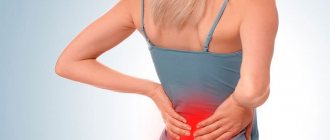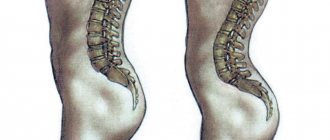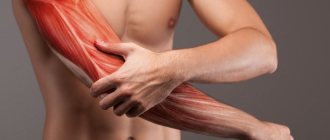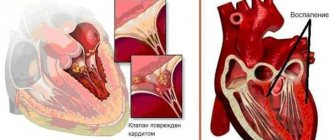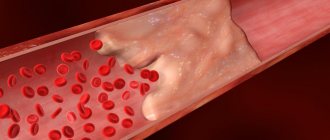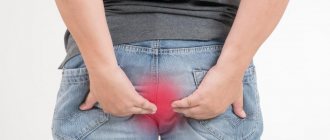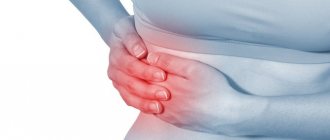Pain Treatment Center
Terekhova
Anna Borisovna
9 years experience
Neurologist-algologist, physical therapy doctor, rehabilitation doctor, Member of the Union of Rehabilitologists of Russia.
Make an appointment
Lumbago is the name of a separate form of osteochondrosis, localized in the lumbosacral region of the spine and accompanied by paroxysmal acute pain in the lower back. An attack usually occurs when you try to sharply bend or straighten your back, as well as when lifting a heavy load. The popular name for the pathology is “lumbago in the lower back.” Most often, the disease occurs in people of young or middle age, from 25 to 45 years, less often in older people, in many cases it is accompanied by sciatica. Men suffer from lumbago more often than women.
Lumbago - what is it?
Lumbago has characteristic symptoms, the main of which are sharp paroxysmal pain in the lower back and muscle spasms. Pathology is more often registered in men aged 30 to 40 years. It quickly becomes chronic, becoming a serious problem for a person.
In the international classification, lumbago disease occurs in two variants:
- M54.4 – lumbago with sciatica (inflammation of the sciatic nerve);
- M54.5 – lumbago NOS (without further specification).
Primary and secondary forms of the pathological condition are also distinguished. In the first case, the pain syndrome is the result of age-related changes in the spine. Secondary lumbago from a clinical point of view is a manifestation of other diseases.
Sources
- Volel Beatrice Albertovna, Petelin D.S., Rozhkov D.O. Chronic back pain and mental disorders // Neurology, neuropsychiatry, psychosomatics. 2021. No. S1.
- Levin O.S., Chimagomedova A.Sh., Shugurova I.M., Nikitina A.N. MODERN APPROACHES TO DIAGNOSIS AND TREATMENT OF CHRONIC BACK PAIN // STPN. 2021. No. 3-4.
- Vyshlova I.A., Starodubtsev A.I. The use of Zhen Ju therapy in the complex treatment of patients with chronic vertebrogenic pain syndromes // Kuban Scientific Medical Bulletin. 2014. No. 5.
Causes of lumbago
Most often, pain in the lower back occurs against the background of osteochondrosis, herniated formations of intervertebral discs and spondyloarthrosis. It can also be the result of severe overstrain of the ligaments and muscles of the back. In approximately 30% of patients, the etiology of lumbago remains unclear, despite comprehensive diagnostics.
The following causes of the disease are identified:
- awkward sudden movements;
- spinal injuries;
- sudden rise in weight;
- staying in an uncomfortable position for a long time;
- hypothermia, especially with previous overheating of the body.
In addition, the causes that lead to the development of degenerative-dystrophic changes in the spine and the formation of intervertebral hernias are involved in the appearance of lumbago. An improper sedentary lifestyle or, conversely, excessive stress on the spine (professional sports, areas of activity associated with physical labor) plays a big role. Also etiological factors are: obesity, poor diet low in vitamins and microelements, some endocrine and metabolic disorders in the body.
Intervertebral disc damage
Mostly lumbago manifests itself in the initial stage of the degenerative process in the intervertebral disc. The latter loses its elasticity and structure. Its nucleus pulposus is deformed, “spreading” to the sides or moving to the side, most often back or back and to the side.
With movement and physical stress, the nucleus pulposus shifts even further, putting pressure on the annulus fibrosus of the disc, which contains sensory receptors. Irritation of peripheral sensory nerve endings causes a response impulse in the structures of the brain, which is manifested by pain, tonic tension of the lower back muscles and reflex reactions.
Vertebral displacement
Symptoms of lumbago can be caused by spondylolisthesis (slipping of an individual vertebra relative to the underlying one). More often, pathology occurs after an accident, an unsuccessful fall, prolonged exposure to an unphysiological position, or after sudden lifting of weights.
Displacement of the vertebral body outside the normal axis of the spine leads to pinching of the nerve trunks and the appearance of severe pain. In most cases, spondylolisthesis is detected at the level of L5-S1, less often - L3-L4. According to various authors, pathology occurs in 2-6% of the population.
Congenital vertebral anomalies
Qualitative and quantitative defects of the lumbar spine often manifest as pain. During sacralization (fusion of the sacrum and the fifth lumbar vertebra), lumbarization (separation of the first sacral vertebra from the sacrum) or fusion of several lumbar vertebrae, compression of the spinal roots may occur. Compression of nerve fibers causes severe pain.
When the shape changes, non-fusion of the vertebral bodies and arches, intervertebral hernias and other pathologies of the spinal column often develop. As a result, painful sensations of varying severity and disturbances in the motor and sensory spheres appear.
Rare causes of lumbago
Very rarely, lumbago occurs against the background of rheumatic diseases, some infectious diseases and tumor processes. In this case, the fibrous ring of the intervertebral disc itself or the ligaments adjacent to it may be affected.
Neoplasms can compress (benign tumors) or grow (malignant tumors) bone, cartilage, muscle and connective tissue structures. The pain is of a pronounced chronic nature. It may not stop for several months or even years.
Prevention
Prevention of lumbago is not difficult. To reduce the frequency of attacks, you must:
- adhere to the work and rest schedule;
- get enough sleep;
- minimize stress;
- regularly engage in amateur sports: walking, morning exercises, swimming;
- eat right, ensure a sufficient amount of vitamins and microelements in the diet;
- normalize body weight if it is excess;
- undergo a course of therapeutic back massage at least once a year;
- avoid heavy lifting;
- undergo timely examination and treat chronic diseases.
Clinical manifestations
The following symptoms are characteristic of lumbago:
- pain;
- muscle spasm;
- impaired mobility in the lumbar region.
In addition, other manifestations characteristic of the disease that caused the development of lumbago may be observed.
Pain
Mostly the symptoms and consequences of lumbago are associated with pain. It is more often symmetrical, less often it occurs on one side. The pain syndrome appears suddenly. People who have experienced an attack of lumbago often characterize it as follows: “as if a stake had been driven into the lower back.”
Sudden intense, sometimes unbearable pain forces a person to freeze in one position. Any movement provokes its strengthening. Often a person cannot even move from his place without outside help.
A painful attack can be localized not only in the lumbar region, but also spread to neighboring anatomical areas (iliac region, buttocks, thighs, lower chest) and internal organs. The pain is felt inside the body, it can be throbbing or shooting, lasting from several minutes to several hours and even days.
Lumbago can stop suddenly, which is sometimes not related to treatment - patients describe this phenomenon as “something in the back has fallen into place.” After an attack, minor symptoms and relatively mild pain are observed in the lumbar region for several days (less often, weeks). They get worse with straining, coughing, sneezing and laughing.
Repeated pain attacks can occur when exposed to provoking factors or without an obvious cause. If lower back pain gradually intensifies over several weeks, then the process is said to be chronic. Painful sensations can practically disappear at rest and recur with movement. Chronic recurrent lumbodynia always indicates the presence of a serious pathology, therefore it is an indication for a comprehensive examination and treatment by a neurologist or osteopath, depending on the mechanism of its development.
Muscle spasm
Often, overstrain of the lower back muscles leads to the appearance of lumbago. The pain, in turn, provokes muscle spasm. Sometimes, due to muscle stiffness, the patient falls, as he cannot move his torso and legs. When the patient stands, his body leans forward slightly.
Loss of mobility in the lower back
During a painful attack, the patient cannot bend at the waist (board symptom). In bed, a person takes a forced body position. Most often, the patient lies on his back with his legs pulled to his stomach, or on his stomach with a pillow placed under him. To sit down, the patient leans on his hands (tripod symptom) and does this with great care.
Diagnosis of lumbodynia
Lumbago disease is detected by a doctor after a comprehensive examination of the patient. The doctor conducts a detailed survey and examination to identify neurological or vertebral symptoms. When palpating the lumbar spine, sharp pain and muscle stiffness are determined.
To clarify the diagnosis, additional diagnostic methods are prescribed:
- radiography, myelography (x-ray with contrast) or CT scan of the spinal column;
- MRI of the lumbar spine;
- lumbar puncture with examination of the obtained cerebrospinal fluid;
- laboratory tests (CBC, blood biochemistry, etc.).
According to indications, the list of examinations is expanded. If necessary, consultations with specialized specialists (vertebrologist, traumatologist, oncologist and others) are carried out.
When excluding tumor, infectious and other processes that require predominantly surgical or drug treatment, an osteopathic examination . This study is carried out by an osteopathic doctor using his hands. Possible causes of impaired blood supply or movement in the lower back area are identified, which could ultimately lead to inflammation or pinched nerves and, ultimately, pain.
Advantages of the clinic
The multidisciplinary clinic “Health Energy” works to help you restore and maintain your main value – health. Choose one of the comprehensive diagnostic programs to find out everything about the condition of the body or contact our doctors for treatment. At your service:
- full diagnostics;
- modern drug regimens;
- physiotherapy, massage, exercise therapy, manual therapy, acupuncture according to indications;
- minor surgical operations within the walls of the clinic;
- own day hospital;
- remote consultations of foreign specialists;
- selection and organization of sanatorium-resort treatment;
- issuing conclusions and certificates.
Lumbago always starts at the wrong time. Rid yourself of painful lumbago, take a course of treatment at “Health Energy”.
Treatment of lumbago
Medical tactics for lumbago are determined taking into account the severity of the pain attack, its etiology and the general condition of the patient. Treatment of lumbago in the lumbar region always begins with bed rest for several days until the intense pain stops.
Make an appointment Biketova Alexandra Viktorovna Osteopathic doctor Specializes in the diagnosis and treatment of pain syndromes in the cervical, thoracic, lumbar spine, chest, shoulder girdle and pelvic area, in the joints of the arms, legs, pain in the foot and heel area, numbness or swelling of the extremities, pain syndromes after operations and injuries of various ages, dysfunction of internal organs with and without pain syndrome. Consultation from 2000 rub.
The patient is recommended to sleep on an orthopedic mattress. It should not sag like a hammock, but at the same time be soft enough to bend around protruding parts of the body. To relax the muscles and give the spine a physiological position, it is advisable to lie on your back with your legs slightly elevated (you can put a pillow or a folded blanket) or lie on your side with your lower limbs bent at the knee and hip joints. Further activation of the patient is carried out gradually, using a special lumbar corset.
The patient is recommended to eat a balanced diet. A temporary restriction of salt in the diet is also required to eliminate tissue swelling.
For each patient, the doctor draws up an individual plan of therapeutic measures. Treatment of lumbago in the lumbar region has two main goals:
- remove symptoms;
- eliminate the causes.
To solve these problems, the doctor can use conservative and surgical methods.
Standard treatment regimen for lumbago
Since the leading manifestation of lumbago is pain, treatment always begins with adequate pain relief. Drug therapy is mandatory:
- analgesics;
- non-steroidal anti-inflammatory drugs;
- antispasmodics;
- anesthetics;
- muscle relaxants;
- tranquilizers.
Painkillers can be used locally in the form of ointments and gels, systemically in the form of tablets, capsules or injections. In severe cases, blockades are performed. Also, depending on the specific disease, additional medications (chondroprotectors, vitamin-mineral complexes, antibiotics, etc.) may be prescribed.
In addition to pharmacotherapy, treatment of lumbago lumbago includes:
- osteopathic sessions to eliminate the root cause of inflammation and lower back pain;
- use of special orthopedic products for the lower back;
- physiotherapy (iontophoresis, ultrasound techniques, UV irradiation, acupuncture, mud applications, magnetic therapy, etc.);
- massage;
- therapeutic exercises.
During the period of remission, treatment at balneological resorts is indicated.
Alternative Treatments for Lumbago
When lumbago occurs, some patients treat themselves at home. This approach is incorrect and dangerous to health. The following folk recipes and methods are most often used to eliminate a pain attack in the lower back:
- dry heat (scarves and belts made of animal hair, heating lamps and heating pads);
- rubbing along the spine and warming compresses with alcohol tinctures of burdock, horseradish, radish, red pepper and other medicinal plants;
- massage with essential oils, bee products and special products;
- drinking tea drinks and decoctions with medicinal herbs;
- compresses with salt.
Self-treatment at home is not recommended. Even the most harmless methods can aggravate the course of the disease. Any action should always be discussed with your doctor.
Treatment of lumbago during pregnancy
Diagnosis and treatment of lumbago in pregnant women is carried out under the supervision of a gynecologist. Many painkillers are contraindicated during pregnancy, so their prescription is carried out according to strict indications.
Treatment of lumbago in pregnant women involves the primary use of topical agents (ointments, patches, gels) and orthopedic products (special corsets and bandages for the lower back).
The method of choice during pregnancy is osteopathy , which has proven its effectiveness and safety for the unborn child. Then massage and physical therapy are added to it.
Rehabilitation treatment after lumbago
After eliminating a pain attack in the lower back, the patient is recommended to follow the following recommendations:
- to live an active lifestyle;
- do exercises daily;
- eat right so that the body receives all the vitamins and minerals;
- give adequate physical activity for the back;
- exclude injuries and any provoking factors (hypothermia, stress, sudden movements in the lower back, etc.);
- promptly treat foci of infection, spinal diseases and systemic diseases;
- sit at work and during rest in the correct posture, incl. while maintaining the natural arch in the lower back – lordosis. To do this, you should take into account the rules of ergonomics, in particular when choosing suitable furniture;
- Plan to visit an osteopath regularly, optimally once every six months, and in case of any injury (not necessarily the spine) - at the first opportunity. During pregnancy, a scheduled visit to an osteopath is recommended once a month.
Rehabilitation treatment of lumbago of the lumbar region is always carried out taking into account the underlying pathology.
What is lumbago with sciatica
Lumbago with sciatica is a pathological condition in which lower back pain is combined with inflammation or pinching of the sciatic nerve. In this case, painful sensations are localized not only in the lumbar region, but also spread to the sacrum, to the buttock, to the femoral area and further down the leg.
The combination of lumbago and sciatica most often occurs due to displacement of the intervertebral discs. It can also signal severe disorders in the spine caused by serious diseases (malignant tumors, purulent processes, etc.).
What is the difference between lumbago and lumbodynia?
Lumbago, in fact, is a variant of lumbodynia, which is a general term for all long-term pain in the lumbosacral area. It can have different causes, related and unrelated to spinal diseases. Lower back pain can appear due to diseases of the internal organs (kidneys, gall bladder, liver, uterus, ovaries and others). Also, its occurrence is facilitated by disruption of the innervation and blood supply to the spinal column. It often accompanies pregnancy.
What exercises help cure lumbago?
Treatment of lumbago in the lumbar region always includes physical therapy. It is prescribed after acute pain has been relieved. A set of exercises is selected by a doctor or exercise therapy instructor for each specific patient, taking into account his individual characteristics. Moderate physical activity has a complex effect:
- strengthen the muscular frame of the lower back;
- keep the vertebrae in a physiological position;
- activate metabolic processes in bone, cartilage, nervous and muscle tissues;
- relieve muscle tension;
- increase the elasticity of ligaments and cartilage;
- launch processes of natural regeneration and restoration;
- improve motor activity in the lower back;
- prevent the appearance of intervertebral hernias and degenerative changes in the spine;
- reduce the risk of recurrence of lumbago.
The set of exercises is selected individually. It is important to strictly follow the technique, otherwise they will be ineffective. A physical therapy instructor will tell you in detail about exercises for lumbago.
How effective are alternative methods of treating lumbago?
Treatment of lumbago in the lumbar region should only be carried out under the supervision of a physician. Sometimes unconventional methods of therapy can produce positive results in some people due to their individual characteristics. However, it is impossible to recommend them to everyone without a preliminary comprehensive medical examination and assessment of the patient’s general condition.
The following symptoms are characteristic of lumbago:
- pain;
- muscle spasm;
- impaired mobility in the lumbar region.
In addition, other manifestations characteristic of the disease that caused the development of lumbago may be observed.
Did you like the article? Add the site to your browser bookmarks
The use of ESWT for pain relief: a review of scientific literature
The fast and persistent antalgic, that is, analgesic, effect determines the high demand for the method of extracorporeal shock wave therapy. A sufficient number of studies have been published confirming the clinical effectiveness of ESWT for acute and chronic pain of various localizations.
The first procedures identify pain triggers that reduce muscle tone, and then the pain gradually decreases as a result of physiological changes under the influence of an acoustic focused shock wave.
W. Baurmeister described the use of ESWT for myofascial pain syndromes, when after one procedure the pain decreased by 26%, after three - by 58.5%, and after 5 procedures it decreased by 87% [23, 24].
Aksenova and Nikolaeva published the results of 650 observations of treatment of myofascial syndromes with the PiezoWave device, and in 96% of cases the pain syndrome was relieved, and the range of movements increased significantly [3].
Sokolov A.N. et al. also used ESWT in 21 patients with myofascial pain syndrome, complaining of aching pain, local hypertonicity, limitation of movements and sleep disturbances. The PiezoWave ESWT device was used; the course of treatment consisted of 5 procedures with a frequency of 4 Hz and a maximum number of pulses of 4000 per session. In all cases, a positive clinical result was observed, pain intensity decreased from 8 to 1 point, and other symptoms regressed [18].
Rice. 6. PiezoWave device
Shtekh L.M. and colleagues treated 86 patients with muscle-articular pain. After 5 procedures, 80% noted a significant improvement, and only 7% of cases showed no improvement [22].

